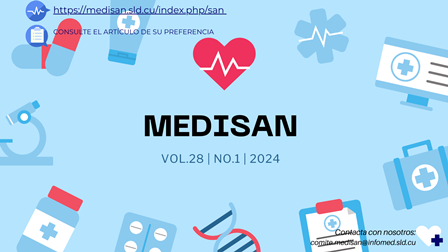Cerebral radionecrosis in an adult
Keywords:
cerebral ventricle neoplasm, glioma, central nervous system, radionecrosis, radiotherapy, immunotherapy.Abstract
The case report of a 37-year-old patient with history of having received radiotherapy due to a tumor lesion in the right frontal region is presented, who attended to the Institute of Neurology and Neurosurgery in Cuba because of intense headache and left hemiparesis. After carrying out the necessary examinations, the clinical-imaging diagnosis of a radionecrosis lesion in the contralateral hemisphere was established, which was corroborated in the pathological examination once the tumor was removed; then, immunotherapy was indicated. The patient had a favorable clinical course because the control of the disease was achieved as well as the resolution of symptoms.
Downloads
References
2. Wernicke AG, Taube S, Smith AW, Herskovic A, Parashar B, Schwartz TH. Cs-131 brachytherapy for patients with recurrent glioblastoma combined with bevacizumab avoids radiation necrosis while maintaining local control. Brachytherapy. 2020 [citado 12/05/2023];19(5):705-12. Disponible en https://www.sciencedirect.com/science/article/abs/pii/S1538472120301318?via%3Dihub
3. Chung C, Bryant A, Brown PD. Interventions for the treatment of brain radionecrosis after radiotherapy or radiosurgery. Cochrane Database of Systematic Reviews. 2018 [citado 12/05/2023];7(7):CD011492. Disponible en: https://www.ncbi.nlm.nih.gov/pmc/articles/PMC6513335/
4. Raggabi A, Bourazza A, Lalya I. Prise en charge de la radionécrose cérébrale: expérience du Service de Neurologie de l'Hôpital Militaire d'Instruction Mohammed V. Pan Afr Med J. 2019 [citado 12/05/2023];33. Disponible en: https://www.panafrican-med-journal.com/content/article/33/188/full/
5. Donovan EK, Parpia S, Greenspoon JN. Incidence of radionecrosis in single-fraction radiosurgery compared with fractionated radiotherapy in the treatment of brain metastasis. Curr Oncol. 2019 [citado 12/05/2023];26(3):e328-e33. Disponible en: https://www.ncbi.nlm.nih.gov/pmc/articles/PMC6588068/
6. Lupattelli M, Alì E, Ingrosso G, Saldi S, Fulcheri C, Borghesi S, et al. Stereotactic Radiotherapy for Brain Metastases: Imaging Tools and Dosimetric Predictive Factors for Radionecrosis. J Pers Med. 2020 [citado 12/05/2023];10(3):59. Disponible en: https://www.ncbi.nlm.nih.gov/pmc/articles/PMC7565332/pdf/jpm-10-00059.pdf
7. Rascón Ramírez FJ, Sallabanda Díaz K, Salazar Ascencio OA, Trondin A, Avecillas Chasín JM. Radionecrosis gigante recurrente imitando un glioma de alto grado: el uso de ácido 5-aminolevulínico como técnica para su diferenciación. Gliomat. 2015 [citado 12/05/2023];1(3):51-3. Disponible en: https://www.researchgate.net/publication/297038197_Radionecrosis_recurrente_imitando_glioma_de_alto_el_uso_de_5-aminolevulinico_como_tecnica_para_su_diferenciacion
8. Erpolat OP, Demircan NV, Sarıbas GS, Kuzucu P, Senturk E, Elmas C, et al. A Comparison of Ramipril and Bevacizumab to Mitigate Radiation-Induced Brain Necrosis: An Experimental Study. World Neurosurg. 2020 [citado 12/05/2023];144:e210-e20. Disponible en: https://www.sciencedirect.com/science/article/abs/pii/S1878875020318489
9. Rascón Ramírez FJ, Salazar Asencio OA, Trondin A. Recurrent Agressive Brain Radionecrosis or High-Grade Glioma: How to Treat? Int J Brain Disord Treat. 2019 [citado 12/05/2023];5(1):1-4. Disponible en: https://clinmedjournals.org/articles/ijbdt/international-journal-of-brain-disorders-and-treatment-ijbdt-5-027.php?jid=ijbdt
10. Sayan M, Şahin B, Zoto Mustafayev T, Sare Kefelioğlu ES, Vergalasova I, Gupta A, et al. Risk of symptomatic radiation necrosis in patients treated with stereotactic radiosurgery for brain metastases. Neurocirugía. 2021 [citado 12/05/2023];32(6):261-7. Disponible en: https://www.revistaneurocirugia.com/es-risk-symptomatic-radiation-necrosis-in-articulo-S1130147320301111
Published
How to Cite
Issue
Section
License
All the articles can be downloaded or read for free. The journal does not charge any amount of money to the authors for the reception, edition or the publication of the articles, making the whole process completely free. Medisan has no embargo period and it is published under the license of Creative Commons, International Non Commercial Recognition 4.0, which authorizes the copy, reproduction and the total or partial distribution of the articles in any format or platform, with the conditions of citing the source of information and not to be used for profitable purposes.





